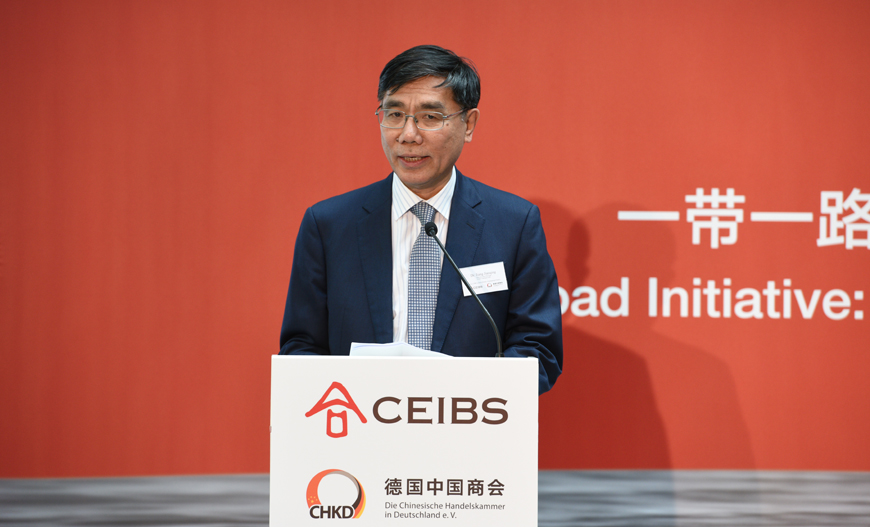Financial Model Innovation & China’s Belt and Road Initiative

~CEIBS Munich Forum
Professor Jiang Jianqing is Chairman of SINO-CEE Fund & Director of CEIBS Lujiazui Institute of International Finance. This is an edited version of his keynote speech at CEIBS 3rd Europe Forum 2017 in Munich on September 13.
“I am honoured to attend this forum organised by CEIBS and to join the discussion with the experts and scholars here about financial model innovation in light of China’s Belt and Road Initiative. Since the Initiative was proposed more than four years ago, the construction progress and achievements have been beyond expectations. This can be seen from the conception of the idea, the unity of participants, the top-level design, and project implementation. Last November during the Fifth Summit of China and Central and Eastern European Countries (China-CEEC Summit), the Sino-CEEF Holding Company and its Sino-Central and Eastern Europe Investment Cooperation Fund (Sino-CEE Fund) were launched to finance and support the construction of the Belt and Road. We are committed to leveraging global capital with a commercialised financial model in order to deepen China’s collaboration with Central and Eastern Europe, and the whole continent. Now I’d like to share three viewpoints that follow the theme of this forum, based on the mission of the Sino-CEE Fund.
First, interpret the Belt and Road Initiative with the idea of “cohesiveness”. The Chinese character “合”(Hé) means mutual understanding, formation of friendship and realising a win-win. Chinese President Xi Jinping’s proposal for the Belt and Road Initiative is not just for China’s interests, but is a global value proposition committed to cooperation and win-win development. It is not a political union consisting of several regions or countries, but a strategic idea committed to the maintenance of world peace, complementary advantages, and mutual connection. It is not an effort seeking short-term benefit, but an idea and attitude of openness, inclusiveness and collaboration.
Its roots are based on China’s Reform and Opening Up Policy that was proposed by Deng Xiaoping in 1978. Back then, China’s GDP totalled RMB 364.5 billion, ranking 10th in the world and accounting for 1.8% of the world’s GDP; its GDP per capita was RMB 381 and the average urban per capita disposable income RMB 343. The total volume of foreign trade in 1978 was USD 35.5 billion, accounting for less than 1% of the world’s total volume, and the foreign exchange reserve balance was USD 200 million. According to the current rural poverty standards, 770 million people lived below the poverty line at that time in China, representing 97.5% of the total rural population.
Since the implementation of the Reform and Opening Up Policy almost four decades ago, China’s GDP surged by 202 times to RMB 74 trillion in 2016, ranking second globally (it has held this position since 2010), accounting for 15.1% of the total world economy. This represents an increase of 13.3% compared to 1978. Its GDP per capita increased by 140 times to RMB 53,817; the foreign-exchange reserve exceeded USD 3 trillion and continues to be the highest in the world; the average urban per capita disposable income reached RMB 33,616, representing an increase of 97 times. In addition, the number of rural poor in China dropped by 94.4% to 43.35 million; the incidence of rural poverty plummeted by 93% to 4.5%. In 2015, China’s total volume of foreign trade was RMB 3.95 trillion, accounting for 11.9% of the world’s total trade volume. China became the largest exporter and second largest importer in the world. In 2013 it became the world’s largest trading nation, overtaking the US which had held that position for the better part of a century. China’s implementation of the Reform and Opening Up Policy enabled the world’s most populated country with the largest population living in poverty to achieve remarkable accomplishments after almost four decades of development. This is unprecedented in both Chinese and human history.
The advancement of globalisation is by no means a smooth road and will go through ups and downs before it sees the bright future. Looking back at China more than three decades ago, a tremendous number of national manufacturers went bankrupt and closed down due to the entry of advanced foreign industries. However, it did not stop China from moving forward and , instead, the country was encouraged to face up to its shortcomings, drop old ways, adopt new methods, and make even greater efforts to stick to the Reform and Opening Up policy. Ever since the implementation of the policy, China has seen the founding of about 830,000 Sino-foreign joint ventures and solely overseas funded ventures and introduced funds of more than USD 1.6 trillion. By learning, cooperating and innovating with an open mind, Chinese economy and industry finally have taken on a new look. China has also grown into the largest trading and manufacturing country, the second largest foreign investor and the third largest foreign investee. This is the magic of Reform and Opening Up. If back then Chinese leaders had failed to have such a political vision and turned to isolation and self-protection, we would not have today’s achievements.
The globalisation process undoubtedly leaves today’s world facing numerous challenges. For example, the gap between rich and poor, regional disparity, geopolitical and cultural conflicts are attracting increasing attention. In the wake of the 2008 global financial crisis, some countries are facing economic decline, sluggish recovery and growing unemployment, which have given rise to the re-emergence of extremism and nationalism. The problems that arise from the globalisation process must certainly be faced, but they can only be tackled through embracing globalisation. Only when national governments, enterprises and people from all countries are jointly committed to the maintenance and development of an inclusive and open world economy with a long-term vision, cooperation, and win-win development can economic globalisation develop in a more healthy direction.
Unfortunately, politicians in some countries have used beggar-thy-neighbour protectionism in trade and investment as a way to relieve their political pressure, divert social conflicts and please their citizens. Direct and indirect nationalistic measures, including selective tariff policies, trade barriers, industrial standards and investment examinations are being introduced. As a matter of fact, “anti-globalisation” trade and investment protectionism is a double-edged sword. It usually leads to vindictive games between countries; countries will not only block others from entering their market, they will also close the gate to their own open development. During the recovery period when the global economy is very vulnerable, the misfortunes these short-sighted and incorrect measures will directly or indirectly cause in the world economy cannot be underestimated.
Today, trade between China and European countries including Germany and the rest of the world has advanced rapidly. Germany is China’s largest trade partner in Europe and sixth largest trade partner globally; China is Germany’s fourth largest export market and second largest source of imports. According to the People’s Republic of China’s Ministry of Commerce and Germany Trade & Invest, in 2016 China-Germany bilateral trade volume reached USD 162.6 billion and Germany’s exports to China totalled USD 83.51 billion, up 7% year-on-year and accounting for 6.4% of Germany’s total exports. Germany’s imports from China totalled USD 77.29 billion, up 0.9% year-on-year and accounting for 7.3% of Germany’s total imports. Germany’s trade surplus with China increased by 154.3% year-on-year and rose to USD 8.02 billion. According to the Ministry of Commerce, in 2016, China’s investment flow into Germany was USD 2.945 billion and the stock of investment reached USD 8.827 billion; Germany launched 392 investment projects in China in 2016 and the total number of projects reached 9,394. The stock of Germany’s investment in China has already reached USD 28.18 billion, almost USD 20 billion higher than the stock of China’s investment in Germany. In 2016, the acceleration of China’s investment in Germany and China’s mergers and acquisitions of German companies bothered some politicians. Given the statistics above, the conclusion is obvious – the rhetoric about trade and investment protectionism aimed at China is groundless.
The history of European development is one of economic globalisation. Central and Eastern European countries have taken openness, inclusiveness and collaboration as the leading factors of economic growth. Currently the global economy and the European economy are still in the difficult recovery process, and they have to depend on global collaboration and joint efforts to work through the difficulties and usher in a new economic revival.
Second, let’s examine opportunities brought about by the Belt and Road Initiative from the perspective of “cohesiveness”. As the Chinese saying goes, “cohesiveness leads to mutual benefit, connection, and win-win”. Every country or company has their own comparative advantage and actively participates in the globalised labour division system. For example, many European countries have unique comparative advantages in the fields of education, technology, culture, healthcare, tourism and sports; on the other hand, after years of reform and development, China boasts a large market size, a relatively large capital advantage, and is comparatively experienced and well-skilled in sectors such as infrastructure, heavy equipment, project contracting, high-speed railway, nuclear power and a number of modern service industries.
After the Cold War, EU member countries and Central and Eastern European countries have been closely linked in areas such as politics, economy, diplomacy, trade, and culture. The Belt and Road Initiative proposed by China does not mean to replace or sideline anyone, but based on the existing foundation, to closely connect the advanced European economic circle and the vigorous Asian economic circle to achieve complementary advantages, resource integration and market connection as a way to strengthen the driving force of development and bridge the gap between rich and poor within the countries, further driving development of economic globalisation in a tolerant and inclusive direction. Therefore, the Belt and Road Initiative is also an historic opportunity, and a project that will run throughout the entire 21st century in Central and Eastern Europe.
Third, we should be innovative in promoting the implementation of the Belt and Road Initiative with “cohesiveness”. Funding is the linchpin for implementation. It is necessary to continuously drive the emerging markets along the Belt and Road to develop quickly through diverse and innovative financial approaches. At present, China-funded banks have set up branches in countries including Poland, the Czech Republic and Hungary. The People’s Bank of China has signed foreign exchange swap agreements with Hungary, Albania and Serbia to conduct RMB clearing, and China joined the European Bank for Reconstruction and Development earlier this year. Germany, France and many other European countries are all founding members of the Asian Infrastructure Investment Bank (AIIB). It is fair to say that the financial partnership between China and Central and Eastern European countries has a strong foundation.
China and Central and Eastern European countries have established the “16+1” leaders’ meeting. This is a good cooperation platform and communication mechanism, and has resulted in fruitful collaboration. One of the innovative results of this is the Sino-CEE Fund cooperation platform. It is an important effort to support the construction of the Belt and Road as well regional collaboration through financial innovation. Transnational investment and fund flows have been heavily impacted by the global financial crisis. Global cross-border liquidity in 2016 was almost one third of that in 2007, and there was an imbalance in structural distribution. Although Central and Eastern European countries have a steady political and policy environment, a sound legal and regulatory system, and have made a relatively successful transformation to market economies, transnational direct investment and capital markets in those countries are still at the early stages of development. They have not yet attracted interest from international equity investors, and offer relatively few fund-raising channels for enterprises; projects lack structural design and many industries have not yet found favour with investors.
Central and Eastern European countries are keen on foreign investment. Taking the regional features and requests for development of Central and Eastern Europe into consideration, we have created innovative financial service models, and under an initiative from the Industrial and Commercial Bank of China (ICBC), set up the Sino-CEE Fund. ICBC is the largest bank in the world, ranking first among the top 2,000 global companies according to Forbes, and it provides comprehensive financial services. The Sino-CEE Fund is a market-driven and commercially-run fund. It attempts to create a benevolent cycle of trans-regional market development and value creation by connecting to global capital with the backing of China and providing an integrated solution characterised by “investment + investment bank + commercial bank”.
The Sino-CEE Fund’s target market is Central and Eastern European countries, as well as the rest of Europe and other regions where they have business relations. The target scale in future is EURO 10 billion and a credit fund of EURO 50 billion is expected to be leveraged. The main targets of investment are projects worthy of commercial development that reflect industrial collaboration and upgrading, and that can push forward regional development and economic growth. We will bring capital to Central and Eastern Europe as well as Chinese partners in order to help their competitive products and services enter the Chinese market and help the companies in this area to grow big and strong. As of now, Central and Eastern European countries’ investment in research and innovation accounts for 1.2% of GDP, which is 0.9% lower than the average percentage of the EU. Chinese companies can cooperate with the competitive companies in the region to work on R&D and innovation, especially in the fields of e-commerce, tourism service, digital technology and telemedicine. Capitalizing on their comparative advantages, the two sides will “turn a corner” and jointly develop the world market.
Since ancient times, China has had the philosophy that man is an integral part of nature. It emphasizes the harmonious coexistence of man and nature and contends that man must do things in compliance with objective social and natural laws. As a commercially-run organization, we not only pursue reasonable economic return, but also attach great importance to social responsibility and value proposition regarding labour relations and product safety. Throughout the process of investment and development, the Sino-CEE Fund will be managed in a way that puts an emphasis on protecting the environment, developing a green, low-carbon economy, and respecting the social and cultural conventions.
At present, the initial fundraising has progressed smoothly and the Fund has identified a batch of potential investment projects in the areas of infrastructure, industrial manufacturing and mass consumption. These projects are now going through the due diligence and evaluation process. At the same time, many Chinese and foreign enterprises as well as financial organisations have shown great interest in investing in Central and Eastern Europe, hoping to seek partnerships and investment opportunities through our platform to jointly build the new blue ocean of overseas investment and industrial integration.
The construction of the Belt and Road is a systematic project, calling for the knowledge of various parties and collaborations between governments, industries and finance organisations. According to The Riga Guidelines for Cooperation between China and Central and Eastern European Countries, we would also like to see financial organisations and companies based in Central and Eastern Europe join the Sino-CEE Fund under the recommendation of the government, and jointly promote the Sino-CEE connection and related industrial collaborations. At present, some Central and Eastern European countries have reached consensus with us about investing in the Fund. We’d like to see more countries participate in building the Fund with us, and hope that national governments and companies will have extensive communication and collaboration on industrial policies, investment environment, project partnership and mergers and acquisitions.
First, the Sino-CEE Fund will utilize its experience and professional network to work together with governments and enterprises to develop commercial designs for projects, and play a leading role in the overall development of the region, and the process of packaging projects and public–private partnerships (PPP). Second, by leveraging our resources we will encourage the involvement from global capital and will initiate the arrangement of financial services, including stock rights, loans, bonds, leases and derivatives, and provide multi-channel solutions. Third, we will play the role of a financial information agency and offer services such as investment consulting, development advising and feasibility studies.
The Sino-CEE Fund, through its efforts to build a platform to facilitate the cooperation between the industries in Central and Eastern European countries and Chinese and global markets, hopes to establish an extensive partnership with all parties in order to grasp the new opportunities created by the implementation of the Belt and Road Initiative, and play a leading role in jointly promoting the development of the globalisation of industry and finance.
Thank you all!”













